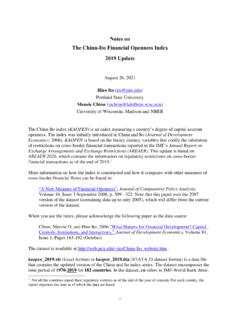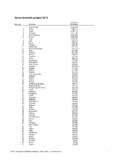Transcription of World Economic Situation - United Nations
1 World Economic Situation Prospects and asdf United Nations New York, 2020. Statistical annex country classifications Data sources, country classifications and aggregation methodology The statistical annex contains a set of data that the World Economic Situation and Prospects (WESP) employs to delineate trends in various dimensions of the World economy. Data sources The annex was prepared by the Economic Analysis and Policy Division (EAPD) of the De- partment of Economic and Social Affairs of the United Nations Secretariat (UN DESA). It is based on information obtained from the Statistics Division and the Population Di- vision of UN DESA, as well as from the five United Nations regional commissions, the United Nations Conference on Trade and Development (UNCTAD), the international monetary fund (IMF), the World Bank, the Organization for Economic Cooperation and Development (OECD), Eurostat and national sources.
2 Estimates for 2019 and forecasts for 2020 and 2021 were made by EAPD in consultation with the regional commissions and UNCTAD, partly guided by the World Economic Forecasting Model (WEFM) of Longer-term projections are based on a technical model-based extension of the WEFM. Data presented in the WESP may differ from those published by other organizations for several reasons, including differences in timing, sample composition and aggregation methods. Historical data may differ from those in previous editions of the WESP because of updating and changes in the availability of data for individual countries. country classifications For analytical purposes, the WESP classifies all countries of the World into one of three broad categories: developed economies, economies in transition and developing econo- The composition of these analytical groupings, specified in tables A, B and C, is intended to reflect basic Economic country conditions, and are not strictly aligned with the regional classifications defined by the Statistics Division of UN DESA known as Ta- ble reports estimates for regional GDP growth according to the M49 definitions for comparison.
3 Several countries (in particular the economies in transition) have characteris- tics that could place them in more than one category; however, for purposes of analysis, the groupings have been made mutually exclusive. Within each broad category, some subgroups are defined based either on geographical location or on ad hoc criteria, such as the subgroup of major developed economies , which is based on the membership of the Group of Seven. 1 See Altshuler et al. (2016). 2 These analytical groupings are not strictly aligned with geographic groupings of Developed Regions and Developing Regions designated by the Statistics Division of UN DESA.
4 3 Full details of the M49 standard can be found on the Statistics Division website at https://unstats. 164 World Economic Situation and Prospects 2020. In parts of the analysis, a distinction is made between fuel exporters and fuel import- ers. An economy is classified as a fuel exporter if the share of fuel exports in its total mer- chandise exports is greater than 20 per cent and the level of fuel exports is at least 20 per cent higher than that of the country 's fuel imports (table D). This criterion is drawn from the share of fuel exports in the total value of World merchandise trade. Fuels include coal, oil and natural gas. For other parts of the analysis, countries have been classified by their level of develop- ment as measured by per capita gross national income (GNI).
5 Accordingly, countries have been grouped as high-income, upper-middle-income, lower-middle-income and low-in- come (table E). To maintain compatibility with similar classifications used elsewhere, the threshold levels of GNI per capita are those established by the World Bank. Countries with less than $1,025 GNI per capita are classified as low-income countries, those with between $1,026 and $3,995 as lower-middle-income countries, those with between $3,996 and $12,375 as upper-middle-income countries, and those with incomes of more than $12,375. as high-income countries. GNI per capita in dollar terms is estimated using the World Bank Atlas method,4 and the classification in table E is based on data for 2018.
6 The list of the least developed countries (LDCs) is determined by the United Nations Economic and Social Council and, ultimately, by the General Assembly, on the basis of recommendations made by the Committee for Development Policy. The basic criteria for inclusion require that certain thresholds be met with regard to per capita GNI, a human assets index and an Economic vulnerability As of December 2018, there were 47. LDCs (table F). The WESP also makes reference to the group of heavily indebted poor countries (HIPCs), which are considered by the World Bank and IMF as part of their debt-relief ini- tiative (the Enhanced HIPC Initiative).
7 6 In December 2018, there were 39 HIPCs (table G). Aggregation methodology Aggregate data are either sums or weighted averages of individual country data. Unless otherwise indicated, multi-year averages of growth rates are expressed as compound annual percentage rates of change. The convention followed is to omit the base year in a multi-year growth rate. For example, the 10-year average growth rate for the decade of the 2000s would be identified as the average annual growth rate for the period from 2001 to 2010. The WESP utilizes market exchange rate conversions of national data in order to aggregate output of individual countries into regional and global totals.
8 The growth of out- put in each group of countries is calculated from the sum of gross domestic product (GDP). of individual countries measured at 2010 prices and exchange rates. This method supplies a reasonable set of aggregate growth rates for a period of about 15 years, centred on 2010. The exchange rate-based aggregation method differs from the one mainly applied by the IMF for their estimates of World and regional Economic growth, which is based on purchasing power parity (PPP) weights. Over the past two decades, the growth of World 4 See 5 Handbook on the Least Developed country Category: Inclusion, Graduation and Special Support Measures ( United Nations publication, Sales No.)
9 Available from development/desa/dpad/wp-content/uploads /sites/45 . 6 international monetary fund , Debt Relief Under the Heavily Indebted Poor Countries (HIPC) In- itiative. Available from Relief- Under-the-Heavily-Indebted-Poor-Countrie s-Initiative. country classification 165. gross product (WGP) on the basis of the exchange rate-based approach has been below that based on PPP weights. This is because developing countries, in the aggregate, have seen significantly higher Economic growth than the rest of the World in the 1990s and 2000s and the share in WGP of these countries is larger under PPP measurements than under market exchange rates.
10 Table in Chapter I reports World output growth with PPP weights as a comparator. Table A. Developed economies Europe Major developed North America European Union Other Europe economies (G7). Canada EU-15 Iceland Canada United States Austriaa Norway France Belgiuma Switzerland Germany Denmark Italy Finlanda Japan Francea United Kingdom Germanya United States Greecea Irelanda Italya Luxembourga Netherlandsa Portugala Spaina Sweden United Kingdomb Developed Asia and Pacific EU-13c Bulgaria Australia Croatia Japan Cyprusa New Zealand a Member of Euro area. Czechia Estoniaa b At the time of writing, the Hungary United Kingdom was a member Latviaa of the EU and is therefore Lithuaniaa included in all EU aggregations.













